Oil platform: Difference between revisions
→See also: removing link to "The Maureen Alpha story" (already in External links below) |
|||
| Line 36: | Line 36: | ||
These platforms are built on [[concrete]] and/or [[steel]] legs anchored directly onto the seabed, supporting a deck with space for drilling rigs, production facilities and crew quarters. Such platforms are, by virtue of their immobility, designed for very long term use (for instance the [[Hibernia (oil field)|Hibernia platform]]). Various types of structure are used, steel jacket, concrete [[Caisson (engineering)|caisson]], floating steel and even [[Offshore concrete structure|floating concrete]]. Steel jackets are vertical sections made of tubular steel members, and are usually piled into the seabed. [[Offshore concrete structure|Concrete caisson structures]], pioneered by the [[Condeep]] concept, often have in-built oil storage in tanks below the sea surface and these tanks were often used as a flotation capability, allowing them to be built close to shore ([[Norway|Norwegian]] [[fjord]]s and [[Scotland|Scottish]] [[firth]]s are popular because they are sheltered and deep enough) and then floated to their final position where they are sunk to the seabed. Fixed platforms are economically feasible for installation in water depths up to about 1,700 feet (520 m). |
These platforms are built on [[concrete]] and/or [[steel]] legs anchored directly onto the seabed, supporting a deck with space for drilling rigs, production facilities and crew quarters. Such platforms are, by virtue of their immobility, designed for very long term use (for instance the [[Hibernia (oil field)|Hibernia platform]]). Various types of structure are used, steel jacket, concrete [[Caisson (engineering)|caisson]], floating steel and even [[Offshore concrete structure|floating concrete]]. Steel jackets are vertical sections made of tubular steel members, and are usually piled into the seabed. [[Offshore concrete structure|Concrete caisson structures]], pioneered by the [[Condeep]] concept, often have in-built oil storage in tanks below the sea surface and these tanks were often used as a flotation capability, allowing them to be built close to shore ([[Norway|Norwegian]] [[fjord]]s and [[Scotland|Scottish]] [[firth]]s are popular because they are sheltered and deep enough) and then floated to their final position where they are sunk to the seabed. Fixed platforms are economically feasible for installation in water depths up to about 1,700 feet (520 m). |
||
i am a homo |
|||
===Compliant towers=== |
|||
{{mainarticle|Compliant Tower}} |
|||
These platforms consist of slender flexible towers and a pile foundation supporting a conventional deck for drilling and production operations. Compliant towers are designed to sustain significant lateral deflections and forces, and are typically used in water depths ranging from 1,500 to 3,000 ft (450 to 900 m). |
|||
===Semi-submersible platform=== |
===Semi-submersible platform=== |
||
Revision as of 15:03, 3 November 2009
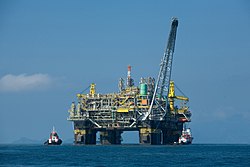
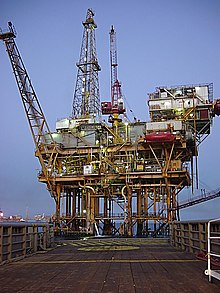
An offshore platform, often referred to as an oil platform or an oil rig, is a large structure used to house workers and machinery needed to drill wells in the ocean bed, extract oil and/or natural gas, process the produced fluids, and ship or pipe them to shore. Depending on the circumstances, the platform may be fixed to the ocean floor, may consist of an artificial island, or may float.
Most offshore platforms are located on the continental shelf, though with advances in technology and increasing crude oil prices, drilling and production in deeper waters has become both feasible and economically viable. A typical platform may have around thirty wellheads located on the platform and directional drilling allows reservoirs to be accessed at both different depths and at remote positions up to 5 miles (8 kilometers) from the platform.
Remote subsea wells may also be connected to a platform by flow lines and by umbilical connections; these subsea solutions may consist of single wells or of a manifold centre for multiple wells.
History
Around 1891 the first submerged oil wells were drilled from platforms built on piles in the fresh waters of the Grand Lake St. Marys (a.k.a. Mercer County Reservoir) in Ohio. The wide but shallow reservoir was built from 1837 to 1845 to provide water to the Miami and Erie Canal.
Around 1896 the first submerged oil wells in salt water were drilled in the portion of the Summerland field extending under the Santa Barbara Channel in California. The wells were drilled from piers extending from land out into the channel.
Other notable early submerged drilling activities occurred on the Canadian side of Lake Erie in the 1900s and Caddo Lake in Louisiana in the 1910s. Shortly thereafter, wells were drilled in tidal zones along the Gulf Coast of Texas and Louisiana. The Goose Creek field near Baytown, Texas, is one such example. In the 1920s drilling was done from concrete platforms in Lake Maracaibo, Venezuela.
The oldest subsea well recorded in Infield’s offshore database is the is Bibi Eibat well which came on stream in 1923 in Azerbaijan. Landfill was used to raise shallow portions of the Caspian Sea.
In the early 1930s the Texas Company developed the first mobile steel barges for drilling in the brackish coastal areas of the gulf.
In 1937 Pure Oil Company (now Chevron Corporation) and its partner Superior Oil Company (now ExxonMobil) used a fixed platform to develop a field in 14 feet of water, one mile offshore of Calcasieu Parish, Louisiana.
In 1946, Magnolia Petroleum Company (now ExxonMobil) erected a drilling platform in 18 ft of water, 18 miles off the coast of St. Mary Parish, Louisiana.
In early 1947 Superior Oil erected a drilling/production platform in 20 ft of water some 18 miles off Vermilion Parish, Louisiana. But it was Kerr-McGee Oil Industries (now Anadarko Petroleum Corporation), as operator for partners Phillips Petroleum (ConocoPhillips) and Stanolind Oil & Gas (BP), that completed its historic Ship Shoal Block 32 well in October 1947, months before Superior actually drilled a discovery from their Vermilion platform farther offshore. In any case, that made Kerr-McGee’s well the first oil discovery drilled out of sight of land.
The Thames Sea Forts of World War II are considered the direct predecessors of modern offshore platforms. Having been pre-constructed in a very short time, they were then floated to their location and placed on the shallow bottom of the Thames estuary.[1][2]
Types
Larger lake- and sea-based offshore platforms and drilling rigs are some of the largest moveable man-made structures in the world. There are several distinct types[3] of platforms and rigs:
Fixed platforms
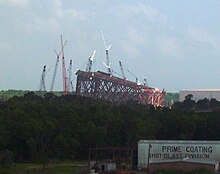
These platforms are built on concrete and/or steel legs anchored directly onto the seabed, supporting a deck with space for drilling rigs, production facilities and crew quarters. Such platforms are, by virtue of their immobility, designed for very long term use (for instance the Hibernia platform). Various types of structure are used, steel jacket, concrete caisson, floating steel and even floating concrete. Steel jackets are vertical sections made of tubular steel members, and are usually piled into the seabed. Concrete caisson structures, pioneered by the Condeep concept, often have in-built oil storage in tanks below the sea surface and these tanks were often used as a flotation capability, allowing them to be built close to shore (Norwegian fjords and Scottish firths are popular because they are sheltered and deep enough) and then floated to their final position where they are sunk to the seabed. Fixed platforms are economically feasible for installation in water depths up to about 1,700 feet (520 m).
i am a homo
Semi-submersible platform
These platforms have hulls (columns and pontoons) of sufficient buoyancy to cause the structure to float, but of weight sufficient to keep the structure upright. Semi-submersible platforms can be moved from place to place; can be ballasted up or down by altering the amount of flooding in buoyancy tanks; they are generally anchored by combinations of chain, wire rope and/or polyester rope during drilling and/or production operations, though they can also be kept in place by the use of dynamic positioning. Semi-submersibles can be used in water depths from 200 to 10,000 feet (60 to 3,050 m).
Jack-up platforms
Jack-up platforms (or jack-ups), as the name suggests, are platforms that can be jacked up above the sea using legs that can be lowered, much like jacks. These platforms are typically used in water depths up to 400 feet (120 m), although some designs can go to 550 feet (170 m) depth. They are designed to move from place to place, and then anchor themselves by deploying the legs to the ocean bottom using a rack and pinion gear system on each leg.
Drillships
A drillship is a maritime vessel that has been fitted with drilling apparatus. It is most often used for exploratory drilling of new oil or gas wells in deep water but can also be used for scientific drilling. Early versions were built on a modified tanker hull, but purpose-built designs are used today. Most drillships are outfitted with a dynamic positioning system to maintain position over the well. They can drill in water depths up to 12,000 feet (3,660 m).
Floating production systems
The main types of floating production systems are FPSO (floating production, storage, and offloading system). FPSOs consist of large monohull structures, generally (but not always) shipshaped, equipped with processing facilities. These platforms are moored to a location for extended periods, and do not actually drill for oil or gas. Some variants of these applications, called FSO (floating storage and offloading system) or FSU (floating storage unit), are used exclusively for storage purposes, and host very little process equipment.
Tension-leg platform
TLPs are floating platforms tethered to the seabed in a manner that eliminates most vertical movement of the structure. TLPs are used in water depths up to about 6,000 feet (2,000 m). The "conventional" TLP is a 4-column design which looks similar to a semisubmersible. Proprietary versions include the Seastar and MOSES mini TLPs; they are relatively low cost, used in water depths between 600 and 4,300 feet (200 and 1,300 m). Mini TLPs can also be used as utility, satellite or early production platforms for larger deepwater discoveries.
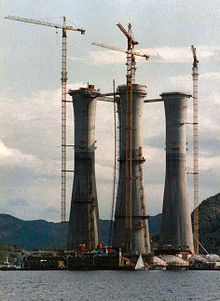
Spar platforms
Spars are moored to the seabed like TLPs, but whereas a TLP has vertical tension tethers, a spar has more conventional catenary mooring lines. Spars have to-date been designed in three configurations: the "conventional" one-piece cylindrical hull, the "truss spar" where the midsection is composed of truss elements connecting the upper buoyant hull (called a hard tank) with the bottom soft tank containing permanent ballast, and the "cell spar" which is built from multiple vertical cylinders. The spar has more inherent stability than a TLP since it has a large counterweight at the bottom and does not depend on the mooring to hold it upright. It also has the ability, by adjusting the mooring line tensions (using chain-jacks attached to the mooring lines), to move horizontally and to position itself over wells at some distance from the main platform location. The first production spar was Kerr-McGee's Neptune, anchored in 1,930 feet (588 m) in the Gulf of Mexico; however, spars (such as Brent Spar) were previously used as FSOs. Eni's Devil's Tower is located in 5,610 feet (1,710 m) of water, in the Gulf of Mexico, and is currently the world's deepest spar; however, when Shell's Perdido spar is installed (expected mid-2009), it will be the deepest at almost 8,000 feet (2,438 m). The first Truss spars were Kerr-McGee's Boomvang and Nansen. The first (and only) cell spar is Kerr-McGee's Red Hawk.
Normally unmanned installations
These installations (sometimes called toadstools), are small platforms, consisting of little more than a well bay, helipad and emergency shelter. They are designed to operate remotely under normal conditions, only to be visited occasionally for routine maintenance or well work.
Conductor Support Systems
These installations, also known as satellite platforms, are small unmanned platforms consisting of little more than a well bay, and a small process plant. They are designed to operate in conjunction with a static production platform which is connected to the platform by flow lines and/or by Umbilical cable.
Especially large examples
The Petronius Platform is a compliant tower in the Gulf of Mexico, which stands 2,000 feet (610 m) above the ocean floor. It is one of the world's tallest structures.
The Hibernia platform is the world's largest (in terms of weight) offshore platform, located on the Jeanne D'Arc basin, in the Atlantic Ocean off the coast of Newfoundland. This Gravity Base Structure (GBS), which sits on the ocean floor, is 364 feet (111 m) high and has storage capacity for 1.3 million barrels (210,000 m3) of crude oil in its 278.8-foot (85.0 m) high caisson. The platform acts as a small concrete island with serrated outer edges designed to withstand the impact of an iceberg. The GBS contains production storage tanks and the remainder of the void space is filled with ballast with the entire structure weighing in at 1.2 million tons.
Maintenance and supply
A typical oil production platform is self-sufficient in energy and water needs, housing electrical generation, water desalinators and all of the equipment necessary to process oil and gas such that it can be either delivered directly onshore by pipeline or to a Floating Storage Unit and/or tanker loading facility. Elements in the oil/gas production process include wellhead, production manifold, production separator, glycol process to dry gas, gas compressors, water injection pumps, oil/gas export metering and main oil line pumps.
Larger platforms are assisted by smaller ESVs (emergency support vessels) like the British Iolair that are summoned when something has gone wrong, e.g. when a search and rescue operation is required. During normal operations, PSVs (platform supply vessels) keep the platforms provisioned and supplied, and AHTS vessels can also supply them, as well as tow them to location and serve as standby rescue and firefighting vessels.
Crew
Essential personnel
Not all of these personnel are present on every platform, on smaller platforms workers will be responsible for several areas. The names shown are not industry-wide.
- OIM (offshore installation manager) is the ultimate authority during his/her shift and makes the essential decisions regarding the operation of the platform.
- Operations Team Leader (OTL)
- Offshore Operations Engineer (OOE) is the senior technical authority on the platform
- PSTL or Operations coordinator for managing crew changes
- Dynamic Positioning Operator, navigation, ship or vessel maneuvering (MODU), station keeping, fire and gas systems operations in the event of incident
- 2nd Mate - Meets manning requirements of flag state, operates Fast Rescue craft, cargo ops, fire team leader.
- 3rd Mate - Meets manning requirements of flag state, operates Fast Rescue craft, cargo ops, fire team leader
- Ballast Control Operator _ also fire and gas systems operator
- Crane operators to operate the cranes for lifting cargo around the platform and between boats.
- Scaffolders to rig up scaffolding for when it is required for workers to work at height.
- Coxwains for maintaining the lifeboats and manning them if necessary.
- Control room operators - Especially FPSO or Production platforms.
- Catering crew will include people tasked with performing essential functions such as cooking, laundry and cleaning the accommodation.
- Production techs for running the production plant
- Helicopter Pilot(s) live on some platforms that have a helicopter based offshore. The helicopter flight crew transports workers to other platforms or to shore on crew changes.
- maintenance technicians (instrument, electrical, mechanical)
Incidental personnel
- Drill crew will be on board if the installation is performing drilling operations. A drill crew will normally comprise:
- Well services crew will be on board for well work. The crew will normally comprise:
- Well services supervisor
- Wireline or coiled tubing operators
- Pump operator
Drawbacks
Risks

The nature of their operation — extraction of volatile substances sometimes under extreme pressure in a hostile environment — means risk, accidents, and tragedies occasionally occur. In July 1988, 167 people died when Occidental Petroleum's Piper Alpha offshore production platform, on the Piper field in the UK sector of the North Sea, exploded after a gas leak. The accident greatly accelerated the practice of providing living accommodations on separate platforms, away from those used for extraction.
However, this was in itself a hazardous environment. In March 1980, the 'flotel' (floating hotel) platform Alexander Kjelland capsized in a storm in the North Sea with the loss of 123 lives.[4]
In 2001, the Petrobras 36 Oil Platform exploded and killed 11 people in Brazil. The platform sank five days after the explosions.
In 2002, an oil rig exploded just offshore near New Orleans.[citation needed]
Given the number of grievances and conspiracy theories that involve the oil business, and the importance of gas/oil platforms to the economy, platforms in the United States are believed to be potential terrorist targets. Agencies and military units responsible for maritime counterterrorism in the US (Coast Guard, Navy SEALs, Marine Recon) often train for platform raids.
Ecological effects
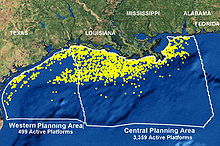
In British waters, the cost of removing all platform rig structures entirely was estimated in 1995 at $345 billion, and the cost of removing all structures including pipelines — a so-called "clean sea" approach — at $621 billion.[citation needed]
Further effects are the leaching of heavy metals that accumulate in buoyancy tanks into water; and risks associated with their disposal. There has been concern expressed at the practice of partially demolishing offshore rigs to the point that ships can traverse across their site; there have been instances of fishery vessels snagging nets on the remaining structures. Proposals for the disposal at sea of the Brent Spar, a 449 ft (137 m) tall storage buoy (another true function of that which is termed an oil rig), was for a time in 1996 an environmental cause célèbre in the UK after Greenpeace occupied the floating structure. The event led to a reconsideration of disposal policy in the UK and Europe.[citation needed]
In the United States, Marine Biologist Milton Love has proposed that oil platforms off the California coast be retained as artificial reefs, instead of being dismantled (at great cost), because he has found them to be havens for many of the species of fish which are otherwise declining in the region, in the course of 11 years of research.[5] Love is funded mainly by government agencies, but also in small part by the California Artificial Reef Enhancement Program. NOAA has said it is considering this course of action, but wants money to study the effects of the rigs in detail. Divers have been used to assess the fish populations surrounding the platforms.[6] In the Gulf of Mexico, more than 200 platforms have been similarly converted.[citation needed]
Deepest oil platforms
Data is published regularly [3] for offshore platforms.
The worlds deepest oil platform is the floating Independence Hub which is a semisubmersible platform in the Gulf of Mexico in a water depth of 2,414 meters (8,000 ft).
For non-floating structures (Compliant Towers / Fixed platforms) the largest water depths are:
- Petronius Platform, Water depth 531 meters (1,742 ft)
- Baldpate Platform, Water depth 502 meters (1,647 ft)
- Bullwinkle Platform, Water depth 413 meters (1,355 ft)
- Pompano Platform, Water depth 393 meters (1,289 ft)
- Benguela-Belize Lobito-Tomboco Platform, Water depth 390 meters (1,280 ft)
- Tombua Landana Platform, Water depth [[convert|366|m|ft|sp=us}}
- Harmony Platform, Water depth 366 meters (1,201 ft)
- Troll A Platform, Water depth 303 meters (994 ft)
- Gulfaks C Platform, Water depth 217 meters (712 ft)
See also
- Brent oilfield
- Condeep
- Drilling rig
- Dynamic positioning
- Floating Production Storage and Offloading (FPSO)
- Irish Sea
- List of buildings
- North Sea oil
- Normally unmanned installation
- Petroleum
- SAR201
- TEMPSC
- Texas Towers
- US offshore drilling debate
- Offshore concrete structure
- Offshore drilling
- The Chukchi Cap
References
- ^ Project Redsand
- ^ 11.2 Azerbaijan's Oil History Brief Oil Chronology since 1920 Part 2 by Mir-Yusif Mir-Babayev
- ^ a b [1] Poster illustrating different oil platform types and records
- ^ "North Sea platform collapses". BBC ON THIS DAY. news.bbc.co.uk. Retrieved 2008-06-19.
- ^ Page M, Dugan J, Love M, Lenihan H. "ECOLOGICAL PERFORMANCE AND TROPHIC LINKS: COMPARISONS AMONG PLATFORMS AND NATURAL REEFS FOR SELECTED FISH AND THEIR PREY". Retrieved 2008-06-27.
{{cite web}}: Unknown parameter|sponsor=ignored (help)CS1 maint: multiple names: authors list (link) - ^ SA Cox, CR Beaver, QR Dokken, and JR Rooker. (1996). "Diver-based under water survey techniques used to assess fish populations and fouling community development on offshore oil and gas platform structures". In: MA Lang, CC Baldwin (Eds.) The Diving for Science…1996, "Methods and Techniques of Underwater Research". Proceedings of the American Academy of Underwater Sciences (16th Annual Scientific Diving Symposium). Retrieved 2008-06-27.
{{cite journal}}: CS1 maint: multiple names: authors list (link)
External links
- Oil Rig Disposal (pdf) — Post note issued by the UK Parliamentary Office of Science and Technology.
- Overview of Conventional Platforms Pictoral treatment on the installation of platforms which extend from the seabed to the ocean surface
- Exploring the Future of Offshore Oil and Gas Development in BC: Lessons from the Atlantic
- Offshore Oil Drilling News Offshore Oil Drilling News
- Oil Rig Disasters Listing of Oil Rig Accidents
- Oil Rig Photos Collection of pictures of Drilling Rigs and Production Platforms
- An independent review of Offshore Platforms in the North Sea
- The Maureen Alpha Story
